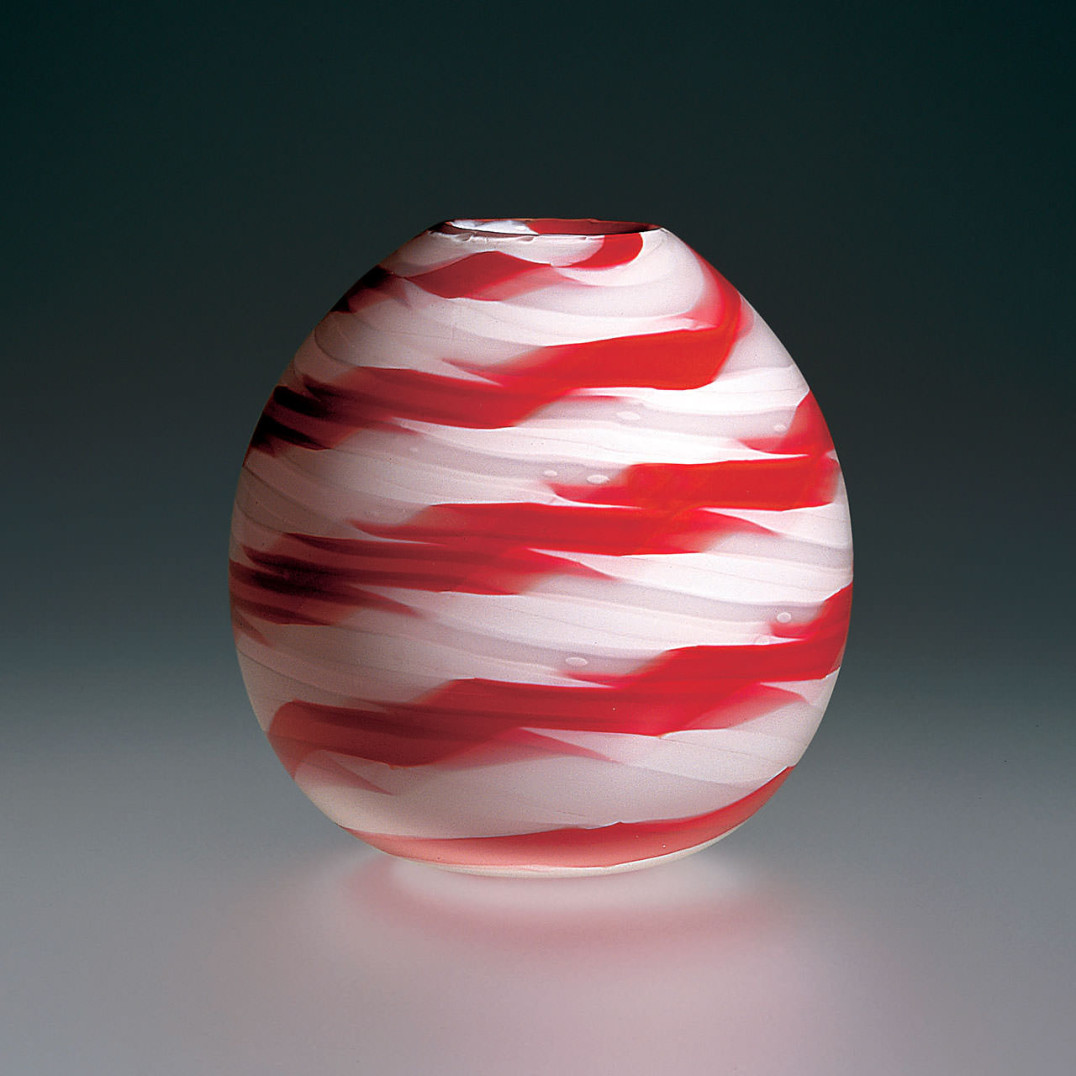
Archimede SegusoZig zag, 1951
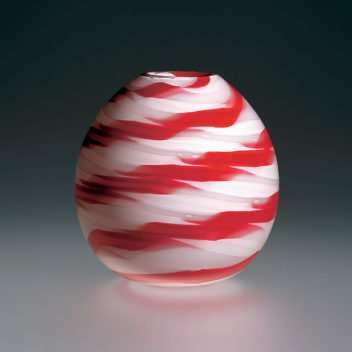
Archimede SegusoZig zagVetreria Archimede Seguso, 1951
Vase in clear transparent glass with inclusions of sections of lattimo and red glass canes laid out in a zig zag pattern. The surface is lightly decorated with the application of a gold leaf.
A similar work is part of
the collection of the Metropolitan Museum of Art in New York.
6 7/8 in. high (17.5 cm)
Exhibitions:
2001, Milan, Murano: Vetri dalla Collezione Olnick Spanu, Spazio Oberdan.
Bibliography and comparative texts:
U. Franzoi, 1991, n. 36;
Olnick Spanu, 2001, n. 156.

Archimede Seguso 1909–1999
Born on Murano and the son of the maestro Antonio Seguso, Archimede Seguso began work at a very early age in the Vetreria Artistica Barovier, where his father was a partner. In 1933, he was one of the founding partners of the Artistica Vetreria e Soffieria Barovier Seguso & Ferro, which was later to become the Seguso Vetri d'Arte. Here, Archimede worked asmaestro of the principal team crafting the pieces designed by Flavio Poli, and later his own pieces inspired by the Novecento style. He sold his share of the workshop to his partners and, in 1946, founded a new workshop, the Vetreria Artistica Archimede Seguso, where he was first maestro and creator of almost all the works produced there. The first glass pieces were still inspired by the Novecento, as were his sculptures modeled in hot glass; at the same time he experimented with thin blown glass textured in many ways, adapting ancient decorative techniques to the styles of the '50s such as, for example, the variations of filigrana that he presented throughout the decade (Merletti, Composizione Lattimo, Piume, etc.). During the '60s and '70s, he created intensely colored glass works such as the colori sovrapposti and the fasce sovrapposte, and further pushed the filigrana technique with his Spinati, and a petali glass pieces. Later on, he based his production on strong contrasting colors. Among his last works is the series of sculptures called Rotture, conceived as original works and made in solid massiccio sommerso glass, a realization of the profound reflections of this artist who later died on the island of Murano.
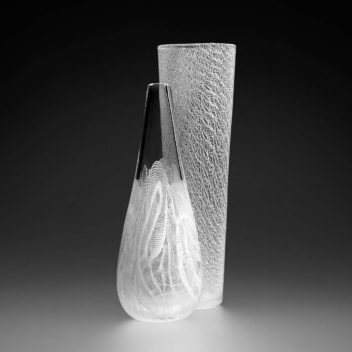
Vetreria Archimede Seguso 1946–
Vetreria Archimede Seguso was founded in 1946 by Archimede Seguso, partner and glassmaster at Seguso Vetri d'Arte until 1942. Seguso was not only the tireless creator of almost all the collections produced by Vetreria Archimede Seguso, he executed his own works and experimented with new techniques and materials. He participated in the Biennali di Venezia and the Triennali di Milano from 1950 on, presenting, among other things, his own personal interpretations of the ancient technique of filigrana. His interpretaions, vessels often enriched with applications of gold leaf, he called Merletti. The company is now run by his son Gino Seguso, with the assistance of his grandson Antonio Seguso.
Archimede SegusoZig zag, 1951
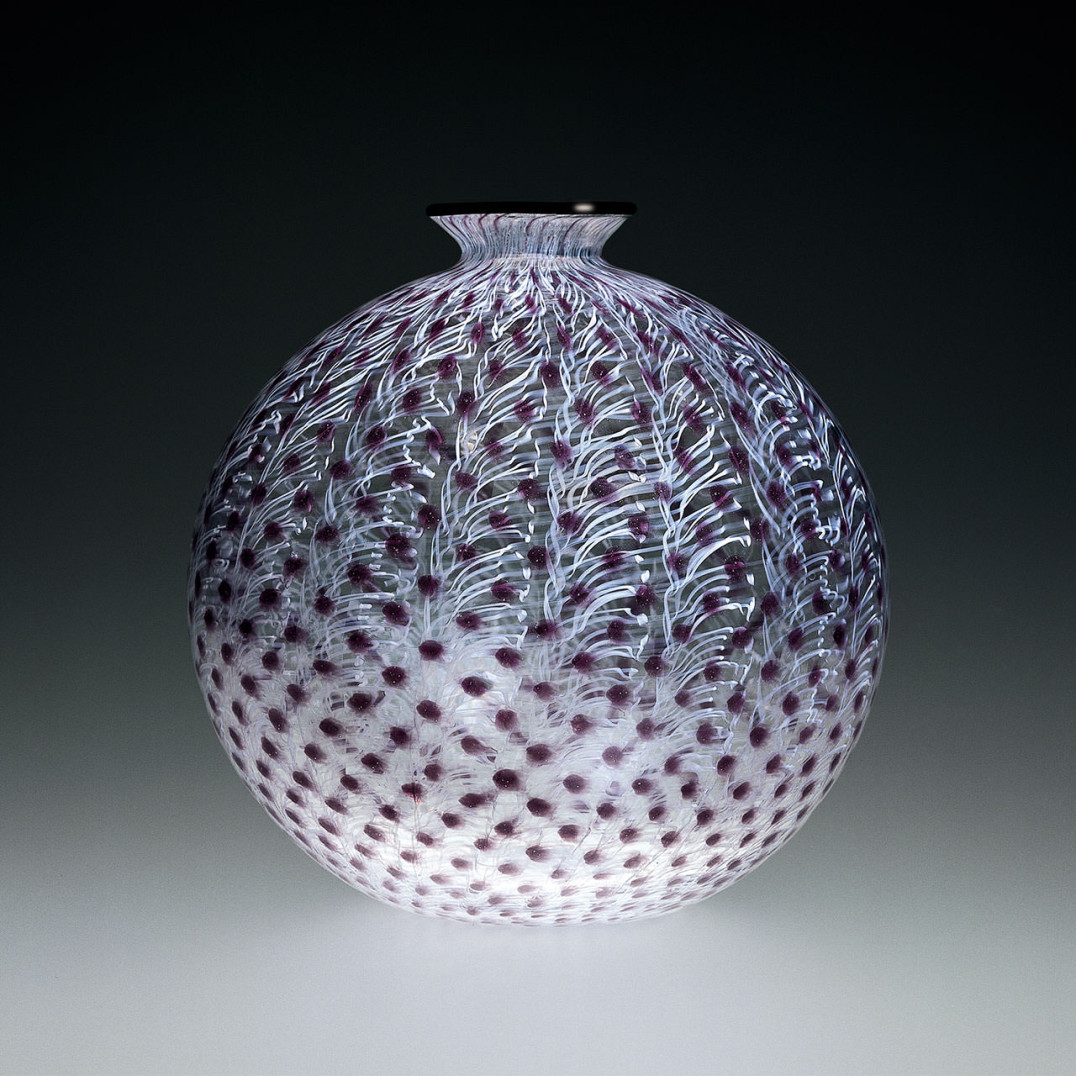
Archimede SegusoMerletto puntiforme, 1954
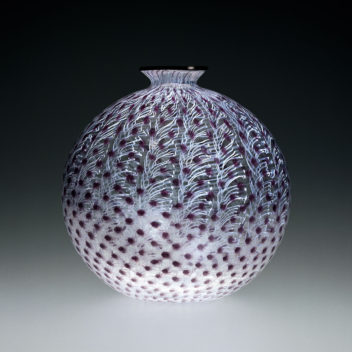
Archimede SegusoMerletto puntiformeVetreria Archimede Seguso, 1954
Globular vase made of transparent glass and decorated with threads of merletto lattimo with the addition of controlled puntini, spots of amethyst glass. Applied amethyst lip wrap.
9 7/16 in. high (24 cm)
Exhibitions:
2000, New York, Venetian Glass, Museum of Arts & Design;
2001, Milan, Murano: Vetri dalla Collezione Olnick Spanu, Spazio Oberdan.
Bibliography and comparative texts:
U. Franzoi, 1991, nn. 22, 86;
R. Barovier Mentasti, 1995, n. 39;
F. Deboni, 1996, n. 130;
H. Ricke, E. Schmitt, 1996, n. 180;
I merletti…, 1999, p. 11;
Olnick Spanu, 2000, n. 115;
Olnick Spanu, 2001, n. 155.

Archimede Seguso 1909–1999
Born on Murano and the son of the maestro Antonio Seguso, Archimede Seguso began work at a very early age in the Vetreria Artistica Barovier, where his father was a partner. In 1933, he was one of the founding partners of the Artistica Vetreria e Soffieria Barovier Seguso & Ferro, which was later to become the Seguso Vetri d'Arte. Here, Archimede worked asmaestro of the principal team crafting the pieces designed by Flavio Poli, and later his own pieces inspired by the Novecento style. He sold his share of the workshop to his partners and, in 1946, founded a new workshop, the Vetreria Artistica Archimede Seguso, where he was first maestro and creator of almost all the works produced there. The first glass pieces were still inspired by the Novecento, as were his sculptures modeled in hot glass; at the same time he experimented with thin blown glass textured in many ways, adapting ancient decorative techniques to the styles of the '50s such as, for example, the variations of filigrana that he presented throughout the decade (Merletti, Composizione Lattimo, Piume, etc.). During the '60s and '70s, he created intensely colored glass works such as the colori sovrapposti and the fasce sovrapposte, and further pushed the filigrana technique with his Spinati, and a petali glass pieces. Later on, he based his production on strong contrasting colors. Among his last works is the series of sculptures called Rotture, conceived as original works and made in solid massiccio sommerso glass, a realization of the profound reflections of this artist who later died on the island of Murano.

Vetreria Archimede Seguso 1946–
Vetreria Archimede Seguso was founded in 1946 by Archimede Seguso, partner and glassmaster at Seguso Vetri d'Arte until 1942. Seguso was not only the tireless creator of almost all the collections produced by Vetreria Archimede Seguso, he executed his own works and experimented with new techniques and materials. He participated in the Biennali di Venezia and the Triennali di Milano from 1950 on, presenting, among other things, his own personal interpretations of the ancient technique of filigrana. His interpretaions, vessels often enriched with applications of gold leaf, he called Merletti. The company is now run by his son Gino Seguso, with the assistance of his grandson Antonio Seguso.
Archimede SegusoMerletto puntiforme, 1954
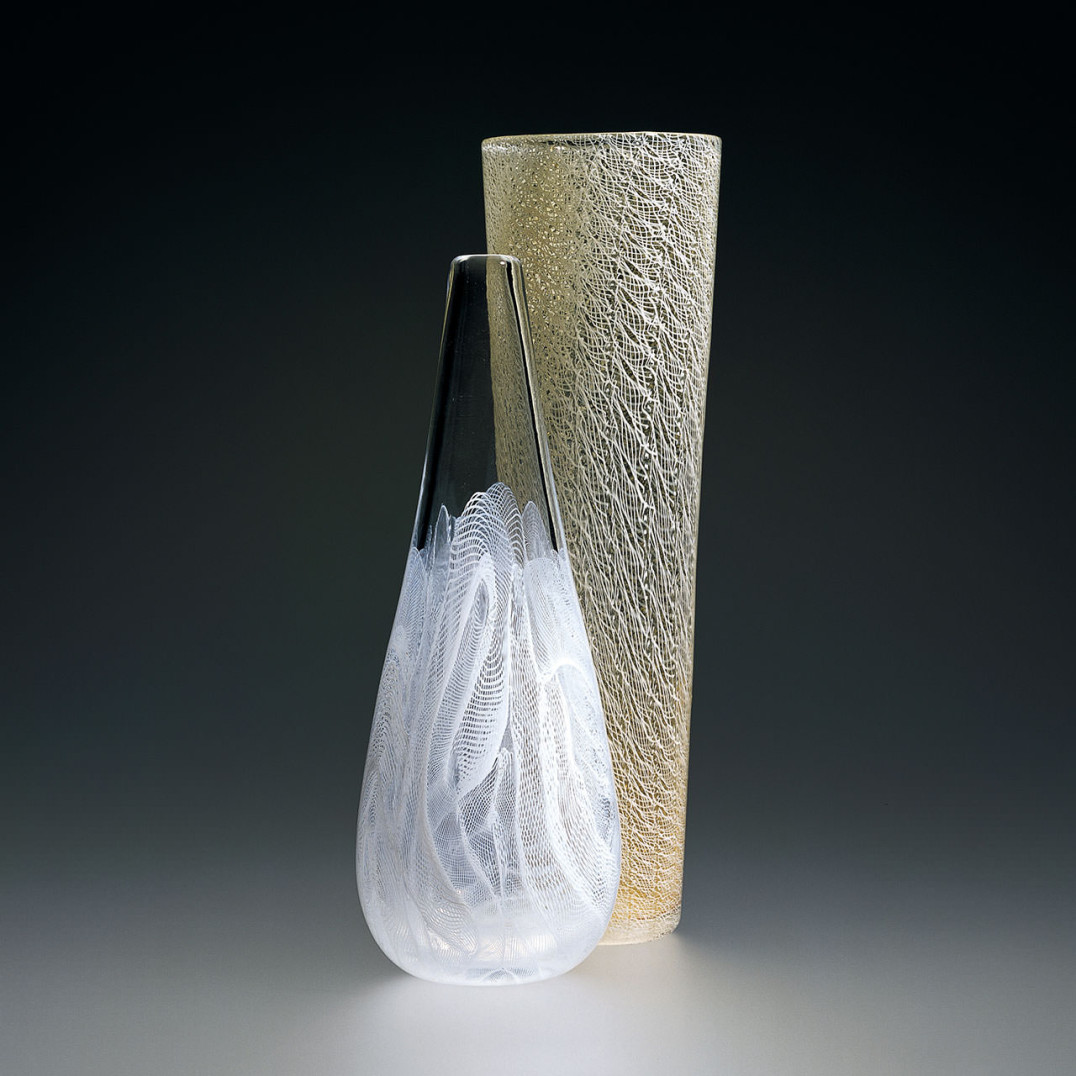
Archimede SegusoComposizione Lattimo, 1954
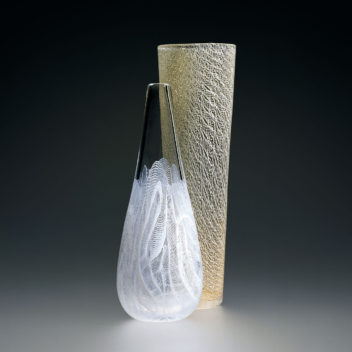
Archimede SegusoComposizione LattimoVetreria Archimede Seguso, 1954
Vase in cristallo glass with the
lower part crafted with canes of mezza filigrana.
13 in. high (33 cm)
Exhibitions:
1954, Venice, 27th Biennale Internazionale d’Arte;
2000, New York, Venetian Glass, Museum of Arts & Design;
2001, Milan, Murano: Vetri dalla Collezione Olnick Spanu, Spazio Oberdan.
Bibliography and comparative texts:
G. Mariacher, 1967, p. 135;
R. Barovier Mentasti, 1982, n. 311;
Mille anni…, 1982, n. 625;
M. Heiremans, 1989, n. 109;
U. Franzoi, 1991, nn. 26, 87-90;
M. Heiremans, 1993, nn. 122, 123;
M. Barovier, R. Barovier Mentasti,
A. Dorigato, 1995, n. 119;
Venezia e la Biennale…, 1995, n. 484;
F. Deboni, 1996, n. 129;
M. Heiremans, 1996, n. 147;
H. Ricke, E. Schmitt, 1996, nn. 185, 186;
Olnick Spanu, 2000, n. 113;
Olnick Spanu, 2001, n. 153.

Archimede Seguso 1909–1999
Born on Murano and the son of the maestro Antonio Seguso, Archimede Seguso began work at a very early age in the Vetreria Artistica Barovier, where his father was a partner. In 1933, he was one of the founding partners of the Artistica Vetreria e Soffieria Barovier Seguso & Ferro, which was later to become the Seguso Vetri d'Arte. Here, Archimede worked asmaestro of the principal team crafting the pieces designed by Flavio Poli, and later his own pieces inspired by the Novecento style. He sold his share of the workshop to his partners and, in 1946, founded a new workshop, the Vetreria Artistica Archimede Seguso, where he was first maestro and creator of almost all the works produced there. The first glass pieces were still inspired by the Novecento, as were his sculptures modeled in hot glass; at the same time he experimented with thin blown glass textured in many ways, adapting ancient decorative techniques to the styles of the '50s such as, for example, the variations of filigrana that he presented throughout the decade (Merletti, Composizione Lattimo, Piume, etc.). During the '60s and '70s, he created intensely colored glass works such as the colori sovrapposti and the fasce sovrapposte, and further pushed the filigrana technique with his Spinati, and a petali glass pieces. Later on, he based his production on strong contrasting colors. Among his last works is the series of sculptures called Rotture, conceived as original works and made in solid massiccio sommerso glass, a realization of the profound reflections of this artist who later died on the island of Murano.

Vetreria Archimede Seguso 1946–
Vetreria Archimede Seguso was founded in 1946 by Archimede Seguso, partner and glassmaster at Seguso Vetri d'Arte until 1942. Seguso was not only the tireless creator of almost all the collections produced by Vetreria Archimede Seguso, he executed his own works and experimented with new techniques and materials. He participated in the Biennali di Venezia and the Triennali di Milano from 1950 on, presenting, among other things, his own personal interpretations of the ancient technique of filigrana. His interpretaions, vessels often enriched with applications of gold leaf, he called Merletti. The company is now run by his son Gino Seguso, with the assistance of his grandson Antonio Seguso.
Archimede SegusoComposizione Lattimo, 1954
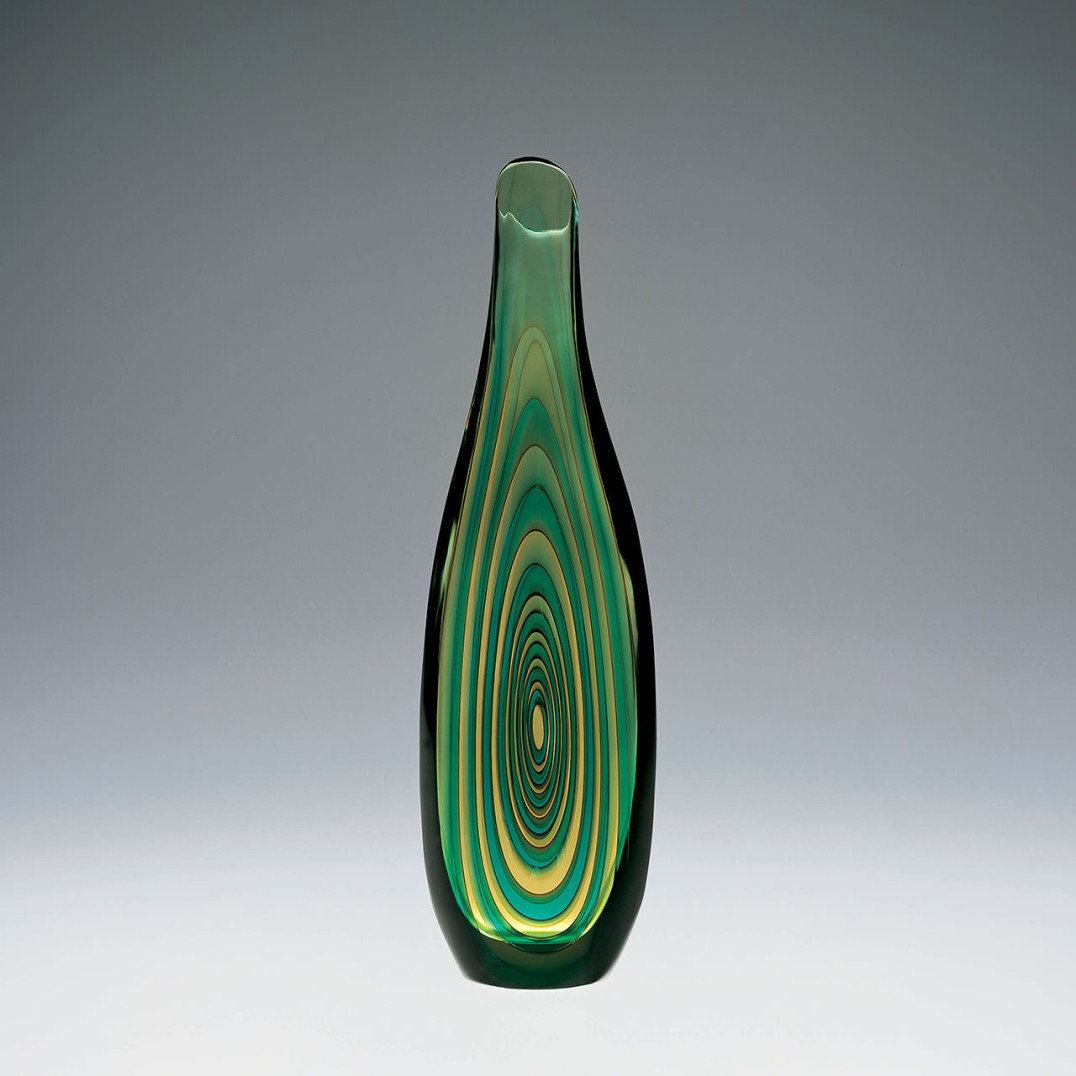
Flavio PoliSiderale, 1952

Flavio PoliSideraleSeguso Vetri d'Arte, 1952
Vase in clear cristallo glass with the inclusion of a large multicolored murrina crafted in concentric circles.
12 3/4 high (32.5 cm)
Exhibitions:
1952, Venice, 26th Biennale Internazionale d’Arte;
2001, Milan, Murano: Vetri dalla Collezione Olnick Spanu, Spazio Oberdan.
Bibliography and comparative texts:
Domus, September 1954;
R. Aloi, 1955, p. 7;
A. Gasparetto, 1960, tb. LII;
W. Neuwirth, 1987, n. 196;
M. Heiremans, 1989, n. 123;
M. Heiremans, 1993, n. 144;
F. Deboni, 1996, n. 146;
M. Heiremans, 1996, n. 121;
Olnick Spanu, 2001, n. 152.
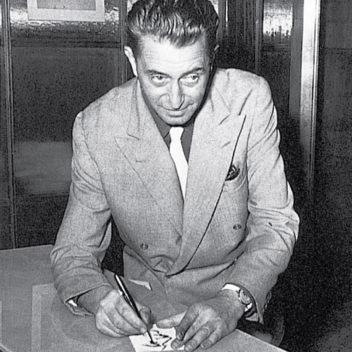
Flavio Poli 1900–1984
A designer, businessman, and ceramic artist, Flavio Poli was born in Chioggia. He attended the Istituto d'Arte di Venezia and began work as a designer in ceramics. In 1929 he switched to glass and designed animals, splendid Novecento-style nude figures in massiccio glass, as well as bowls and urns with figures resting on the inside, on lids or as handles for Libero Vitali's I.V.A.M. He subsequently collaborated with the Compagnia di Venezia e Murano, with the furnace of Mario and Lino Nason, and with the engraver Gino Francesconi. In 1934, he accepted the artistic direction of Barovier, Seguso & Ferro, later to become Seguso Vetri d'Arte, and became partner three years later. Together with Archimede Seguso, maestro of the principal team, Poli authored grandiose lighting installations, corroded vessels, sculptures in bulicante glass, and animals in massiccio glass. These productions represented a milestone in the development of the glassworks of Murano. At the height of his artistic maturity, in the years between 1950 and 1960, he designed a series of sommerso glass pieces in a Nordic style—essential forms and sharp cold colors—which were awarded prestigious prizes (Compasso d'Oro). He left Seguso in 1963 and between 1964 and 1966, he organized the artistic glass division at the Società Veneziana di Conterie e Cristallerie.
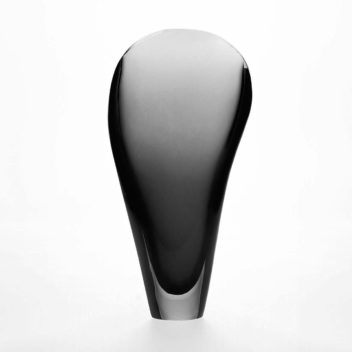
Seguso Vetri d'Arte 1937–1972
In 1933, several maestri who had left Vetreria Artistica Barovier, together with Archimede, Ernesto, and Alberto Seguso, founded the Vetreria e Soffieria Barovier Seguso & Ferro. Muranese painter Vittorio Zecchin took on the art direction for a short time with Flavio Poli replacing him in 1934. The company was reorganized in 1937 to become Seguso Vetri d'Arte. At this time, Poli also became a partner, and with the assistance of the maestro Archimede Seguso, they created animals and sculptures in thick glass, which were widely acclaimed at the Biennali of that period. After a new company reorganization in the '50s and '60s, the glasshouse produced a remarkable series of sommersi pieces, as well as the Valve and the unique Siderali pieces. The latter were designed by Poli, who remained in the company until 1963. After he left, Mario Pinzoni took over the artistic direction and remained stylistically faithful to his predecessor. Since the early '60s, the company has been directed by Maurizio Albarelli.
Flavio PoliSiderale, 1952
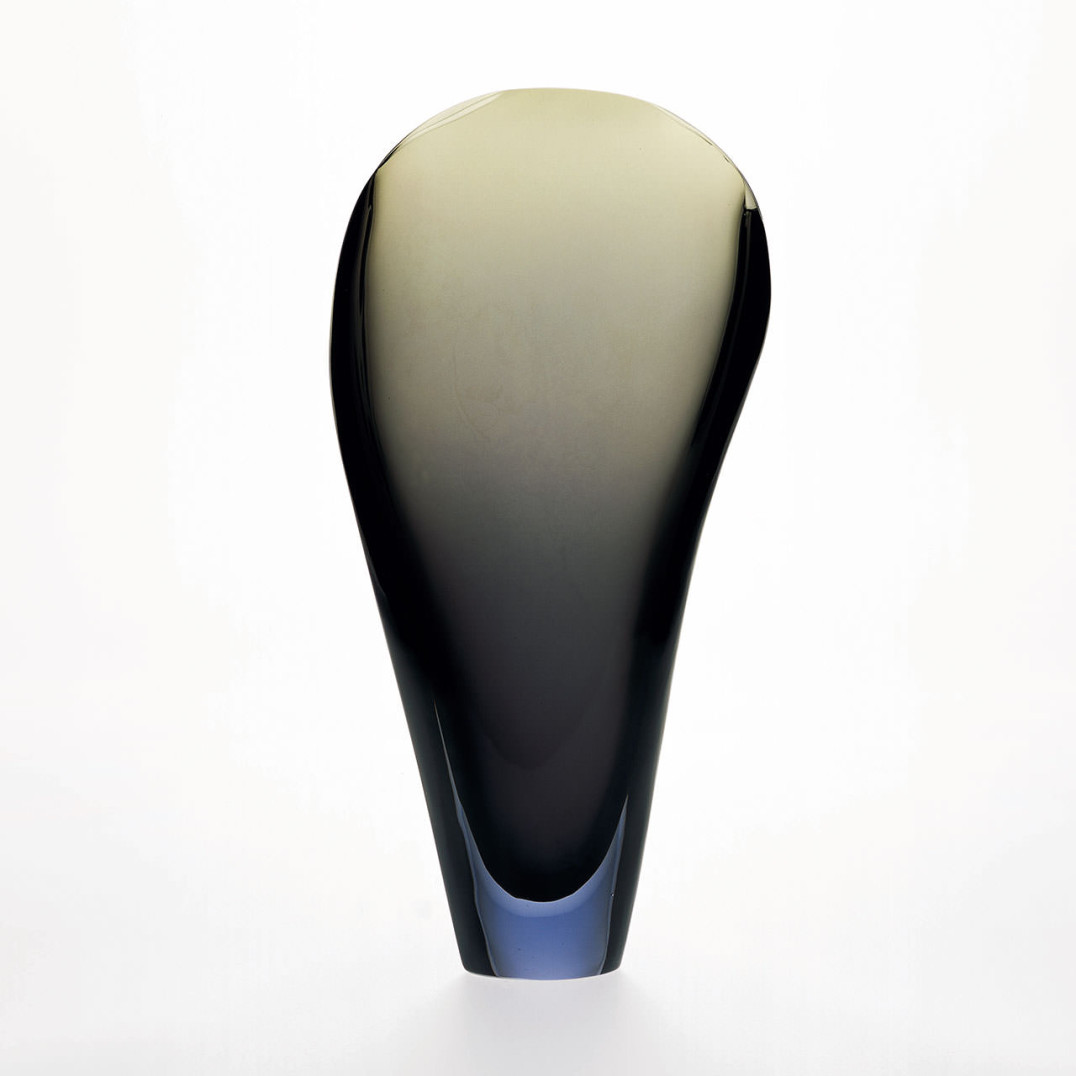
Flavio PoliValva, 1954
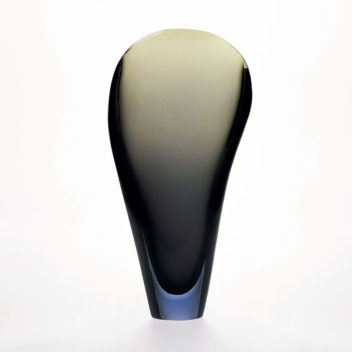
Flavio PoliValvaSeguso Vetri d'Arte, 1954
A sculptural vase shaped like a clam shell; composed of transparent grey sommerso in cristallo glass.
17 7/8 in high (45.5 cm)
Exhibitions:
1954, Venice, 27th Biennale Internazionale d’Arte;
2000, New York, Venetian Glass, Museum of Arts & Design;
2001, Milan, Murano: Vetri dalla Collezione Olnick Spanu, Spazio Oberdan.
Bibliography and comparative texts:
Domus, September, 1954;
R. Aloi, 1955, p.2;
G. Mariacher, 1967, p. 141;
R. Barovier Mentasti, 1977, n. 136;
Mille anni…, 1982, n. 639;
Die funfziger…, 1984, n. 10;
W. Neuwirth, 1987, n. 223;
La verrerie…, 1988, nn. 1, 6;
M. Heiremans, 1989, n. 113;
M. Karasik, 1989, n. 45;
M. Barovier, R. Barovier Mentasti,
A. Dorigato, 1995, n. 112;
M. Heiremans, 1996, n. 120;
H. Ricke, E. Schmitt, 1996, n. 13;
M. Barovier, 1999, p. 209;
Olnick Spanu, 2000, n. 112;
Olnick Spanu, 2001, n. 151.

Flavio Poli 1900–1984
A designer, businessman, and ceramic artist, Flavio Poli was born in Chioggia. He attended the Istituto d'Arte di Venezia and began work as a designer in ceramics. In 1929 he switched to glass and designed animals, splendid Novecento-style nude figures in massiccio glass, as well as bowls and urns with figures resting on the inside, on lids or as handles for Libero Vitali's I.V.A.M. He subsequently collaborated with the Compagnia di Venezia e Murano, with the furnace of Mario and Lino Nason, and with the engraver Gino Francesconi. In 1934, he accepted the artistic direction of Barovier, Seguso & Ferro, later to become Seguso Vetri d'Arte, and became partner three years later. Together with Archimede Seguso, maestro of the principal team, Poli authored grandiose lighting installations, corroded vessels, sculptures in bulicante glass, and animals in massiccio glass. These productions represented a milestone in the development of the glassworks of Murano. At the height of his artistic maturity, in the years between 1950 and 1960, he designed a series of sommerso glass pieces in a Nordic style—essential forms and sharp cold colors—which were awarded prestigious prizes (Compasso d'Oro). He left Seguso in 1963 and between 1964 and 1966, he organized the artistic glass division at the Società Veneziana di Conterie e Cristallerie.

Seguso Vetri d'Arte 1937–1972
In 1933, several maestri who had left Vetreria Artistica Barovier, together with Archimede, Ernesto, and Alberto Seguso, founded the Vetreria e Soffieria Barovier Seguso & Ferro. Muranese painter Vittorio Zecchin took on the art direction for a short time with Flavio Poli replacing him in 1934. The company was reorganized in 1937 to become Seguso Vetri d'Arte. At this time, Poli also became a partner, and with the assistance of the maestro Archimede Seguso, they created animals and sculptures in thick glass, which were widely acclaimed at the Biennali of that period. After a new company reorganization in the '50s and '60s, the glasshouse produced a remarkable series of sommersi pieces, as well as the Valve and the unique Siderali pieces. The latter were designed by Poli, who remained in the company until 1963. After he left, Mario Pinzoni took over the artistic direction and remained stylistically faithful to his predecessor. Since the early '60s, the company has been directed by Maurizio Albarelli.